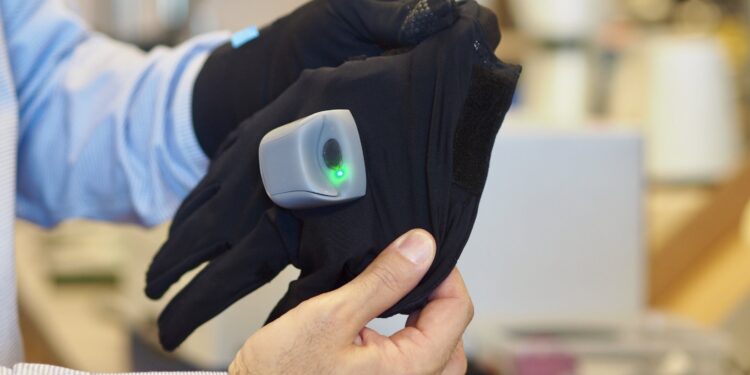The glove is cordless, stretchy and can be easily washed after removing the battery. Credit: Lou Bosshart
This month, a group of stroke survivors in British Columbia will test new technology designed to aid their recovery and ultimately restore use of their limbs and hands.
Participants will wear a revolutionary new “smart glove” that can track the movements of their hands and fingers during rehabilitation exercises supervised by Dr. Janice Eng, a leading stroke rehabilitation specialist and professor of medicine at the UBC.
The glove incorporates a sophisticated network of sensor wires and highly sensitive pressure sensors woven into comfortable stretch fabric, allowing it to wirelessly track, capture and transmit even the smallest hand and finger movements.
“With this glove, we can monitor patients’ hand and finger movements without the need for cameras. We can then analyze and refine their exercise programs to achieve the best possible results, even from a distance,” explains Dr. Eng .
Precision in a portable device
Professor of Electrical and Computer Engineering at UBC, Dr. Peyman Servati, Ph.D. student Arvin Tashakori and their team at their startup, Texavie, created the smart glove to collaborate on the AVC project. Dr. Servati highlighted a number of breakthroughs, outlined in an article published last week in Intelligence of natural machines.
“This is the most precise glove we know of, capable of tracking hand and finger movements and grip strength without requiring motion capture cameras. Using the machine learning models we developed, the glove can accurately determine the angles of all finger and wrist joints. “The technology is very precise and fast, able to detect small stretches and pressures and predict movements with at least 99% accuracy, which matches the performance of expensive motion capture cameras,” the authors observe.
Unlike other products on the market, the glove is wireless and comfortable, and can be easily washed after removing the battery. Dr. Servati and his team have developed advanced methods to locally manufacture smart gloves and associated clothing at relatively low cost.
UBC professor of electrical and computer engineering, Dr. Peyman Servati, Ph.D. student Arvin Tashakori and his team at their startup, Texavie, created the smart glove to collaborate on a study on stroke therapy . Credit: Lou Bosshart/UBC Media Relations
Augmented reality and robotics
Dr. Servati envisions a smooth transition of the glove to the consumer market with continued improvements, in collaboration with various industrial partners. The team also sees potential applications in virtual reality and augmented reality, animation and robotics.
“Imagine being able to accurately capture hand movements and interactions with objects and automatically display them on a screen. The applications are endless. You can type without needing a physical keyboard, control a robot or translate American Sign Language into written speech in real time, making communication easier for people who are deaf or hard of hearing.”
More information:
Arvin Tashakori et al, Capturing complex hand movements and object interactions using machine learning-based stretchable smart textile gloves, Intelligence of natural machines (2024). DOI: 10.1038/s42256-023-00780-9
Provided by University of British Columbia
Quote: ‘Smart glove’ can improve hand mobility in stroke patients (January 16, 2024) retrieved January 16, 2024 from
This document is subject to copyright. Except for fair use for private study or research purposes, no part may be reproduced without written permission. The content is provided for information only.



